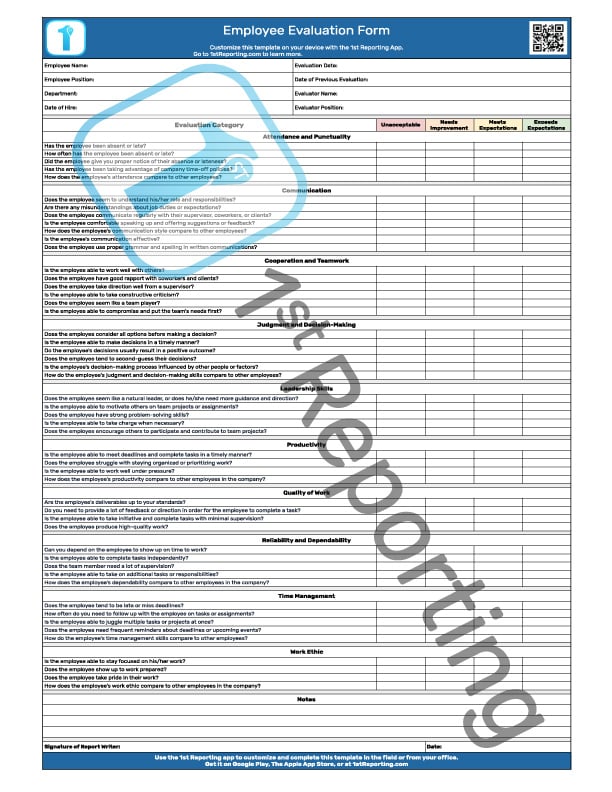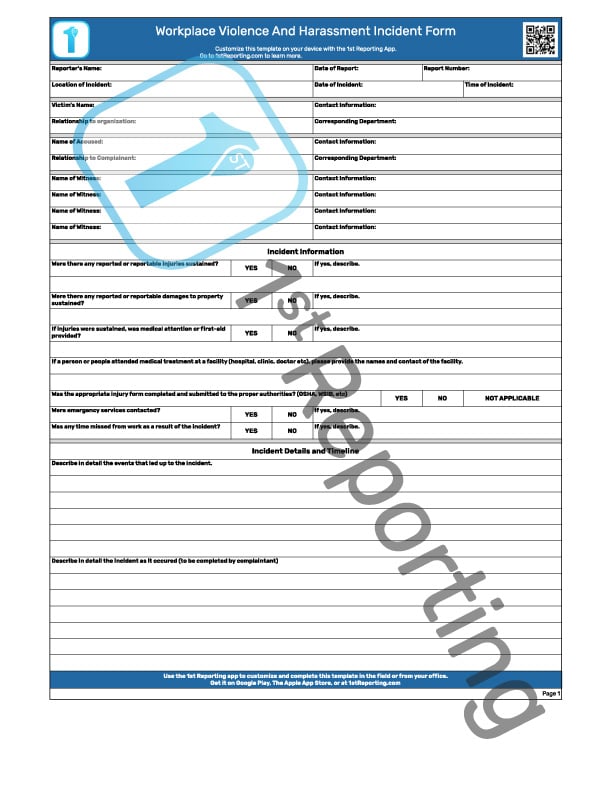When you have team member reviews to do, the Employee Evaluation Form is a convenient tool to get the job done. Employee evaluation forms are used during the employee review process to document the findings of the team member evaluation. These forms are typically used by managers, supervisors, and business owners. The form is highly effective for human resources and management to document and track team member performance.
This guide and downloadable template for employee evaluations are all you need for effective employee evaluation management. Read on for tips and best uses of the tool for optimal team member evaluation results. It will help you speed up the process for a more efficient and effective employee management solution.
Included In The Employee Evaluation Form
The employee performance evaluation form is conveniently segmented into 12 sections. Each of the 12 sections corresponds to a team member’s evaluation measurable category. These 12 measurable categories were determined from extensive research into multiple industries and the values that managers in those industries deemed critical to team member performance.
Administrative Section
Performance appraisal forms must include information like the employee’s name and date of employment review.
Attendance and Punctuality
Team members are often evaluated on their attendance and punctuality, as these factors can significantly impact overall team performance. Tracking attendance and punctuality is a fundamental metric when considering how to complete an employee evaluation correctly.
Communication
Effective communication is essential for any team to succeed. As such, managers often evaluate team members’ communication skills and ability to collaborate with their peers.
Remember while assessing employee communication that communication is a two-way conversation. You should provide detailed feedback to the, and similarly, you should expect to gather feedback from the employee. Proper communication requires employee engagement and communication back and forth between both the reviewer and the reviewed.
Cooperation and Teamwork
Team members perform best when they work together and support one another. Whether through conflict resolution, listening to feedback, or sharing ideas, a team is most potent when each member works together towards common goals. That’s why documenting cooperation in teamwork during your team member evaluation is critical.
During the employee audits, documenting the employee’s collaboration skills and other employee strengths is an essential performance goal metric that helps managers and provides management with useful introductory information.
Judgment and Decision-Making
A key measurable for team members is their ability to make good decisions and judgments. It involves weighing different options, considering relevant information, and taking the perspectives of others into account. Successful team members can balance competing priorities, use analytical skills effectively, and evaluate risks when making decisions.
Leadership Skills
Another critical measure of team member performance is their ability to lead and motivate others. It includes setting clear goals, delegating tasks effectively, providing support and feedback, and encouraging collaboration among team members. Influential leaders are also skilled at working with individuals from various backgrounds and cultures, communicating clearly, and establishing trust within the team.
Productivity
Tracking team member productivity against expectations is vital to understanding team member performance. To help any team member better perform in their role, you must create a baseline for role expectations and communicate those expectations with the team member involved.
Quality of Work
Quality of work is synonymous with craftsmanship and professionalism. Tracking the quality of work provided by employees is a crucial metric critical for understanding employees’ overall performance and aptitude in their role.
Reliability and Dependability
As a manager or owner, you know that reliability and dependability are key performance metrics when evaluating employee performance. During an employee performance audit, you must consider all variables and understand how the reliability and dependability of your team members affect overall team performance. Utilizing an employee evaluation form like the one provided today is an excellent way of tracking team member reliability and dependability over time.
Time Management
Time management is one of the most sought-after skills in today’s labor market. In such a fast-paced world, time management has become a vital skill necessary today. Tracking time management and evaluating the time management of employees is critical to assessing the overall performance of the team member in their roles.
Work Ethic
The final team member evaluation metric on the Employee Evaluation Form template deals with work ethic. The work ethic of a team member is critical to overall performance evaluation and company success. Whether employees are part of small businesses or large corporations, noting work ethic is vital to professional development and the performance improvement plan.
Notes And Sign-Off
Cut the footer of the team member evaluation form. You’ll find written comments and a sign-off section. The notes section allows the employee evaluator to include any final thoughts post valuation. Finally, the sign-off provides a measure of authenticity to the performance review template by providing a space for the evaluator to both sign and date the document.
Best Practices For Using Team Member Evaluation Forms

Predetermine Key Deliverables Of Each Role Before Evaluation
Performance metrics are an essential factor in evaluating team member performance, and they must be established at the beginning of the evaluation process. It ensures that both the employee and their manager have a clear understanding of what is expected from the role so that you can effectively assess that performance against these standards.
Another essential best practice when using performance metrics is carefully considering which metrics are most relevant to each employee’s work performance. While many organizations utilize a standard set of performance metrics across all roles, it may be more effective to customize these measures based on factors such as an individual’s specific responsibilities or goals within the organization.
Communicate Deliverables And Expectations To Each Member Of The Team Corresponding To Their Role
In addition to determining performance metrics, it is also essential to develop consistent and clear employee evaluation guidelines. It includes providing information on performance expectations and documenting specific performance indicators that you will use to measure performance.
You must inform employees of the job description to understand the role requirements for successful employee reviews. It is as crucial as communicating the review period.
Regularly Review Performance Data With Each Employee, Highlighting Both Strengths And Areas For Improvement
Once performance metrics have been established and communicated to employees, it is essential to monitor performance against these benchmarks regularly. It can include frequent feedback sessions between managers and employees and ongoing documentation of progress in critical deliverables.
By incorporating these practices into the review process, organizations can help ensure that employees are being evaluated fairly and consistently across all roles within the organization.
Prepare Thoroughly For Employee Evaluations
Conducting an effective performance review requires good preparation. Before completing employee performance evaluation forms, you should know what you want to discuss. It will help ensure that the conversation stays focused on critical points and doesn’t get sidetracked. To avoid confusion and provide clarity, it can be helpful to write down your objectives for the discussion in advance. Listing out key takeaways will also help keep everyone on the same page.
Some things to consider when preparing for a team member performance review:
- What were the employee’s objectives and goals for the performance period?
- What deliverables did they complete during the performance period?
- What progress has been made towards their objectives and goals?
- What challenges or obstacles did they encounter during the performance period?
- Are there any areas where they could improve their performance?
- What are their strengths and weaknesses?
- What are some ideas for how they can improve their performance in the future?
By preparing for performance reviews in advance, you can ensure that the meeting is productive and efficient and that both you and the employee walk away with a clear understanding of their performance.
Set Up And Communicate An Evaluation Schedule For Each Role Within The Organization

You should conduct performance reviews regularly, typically at least once per year. However, the frequency of the performance review pers may vary depending on the organization’s needs and the specific role being evaluated. It is essential to establish a schedule for the company’s performance management process so that employees know when they can expect to receive feedback on their employee evaluation.
Communicating the evaluation schedule to employees in advance will help to ensure that everyone is on the same page and knows when to expect detailed feedback. Additionally, setting up a regular schedule for performance audits helps ensure that employees are being assessed consistently and fairly across all roles within the organization.
When determining the frequency of performance evaluations, it is essential to consider both the needs of the organization and the preferences of employees. Some employees may prefer to receive performance feedback more frequently, while others may receive it less often. It is vital to strike a balance between the needs of the organization and the preferences of employees when setting up the evaluation schedule.
Some factors to consider when determining the frequency of performance audits:
– The specific role being evaluated
– The size of the organization
– The goals of the review
– The preferences of employees
Once you have determined how often you should conduct performance evaluations, it is essential to communicate this information to employees. It will help ensure that everyone is aware of when they can expect to receive feedback on their performance. Additionally, sending out reminders before performance review meetings can help to ensure that employees are prepared for the discussion.
Utilize Different Performance Metrics For Each Role To Ensure A Tailored And Effective Evaluation
Not all performance audits should be the same. The performance metrics you use to assess an employee’s performance should be tailored to their specific role within the organization. Using different performance metrics for each role can ensure that the evaluation process is adequate and relevant.
Some factors to consider when choosing performance metrics:
– The objectives and goals of the performance period
– The responsibilities of the role being evaluated
– The skillsets required for the role being evaluated
– The size of the organization
– The industry in which the organization operates
Using different performance metrics for each role helps ensure that employees are being assessed fairly and accurately across all functions within the organization. Additionally, it allows you to tailor the performance evaluation audit to the organization’s needs.
Ensure That All Employees Have Access To The Performance Metric Criteria Being Used For Their Evaluation
When setting performance metrics for each role within the organization, it is essential to ensure that all employees have access to this information. It will help them understand how they are being evaluated and what criteria they need to meet to succeed.
Some methods for communicating performance standards criteria:
– Publishing performance metric criteria on the company’s intranet or website
– Sending out regular reminders before performance review meetings
– Including metric performance criteria in employee handbooks and onboarding materials
By ensuring that all employees have access to metric performance criteria, you can create a more fair and transparent review. Additionally, this will help employees feel more confident in their ability to succeed and reach their goals.
Make Sure That The Employee Performance Evaluation Stays On Schedule
Many businesses face the postponement of team member role reviews. It would be best if you did not postpone an employee evaluation due to Common day-to-day operations that should not affect the performance review process. Delaying performance reviews shows employees that employee evaluation is not essential to management. You must document the employee’s performance on your employee evaluation form, and You must communicate the employee evaluation form to the employee in the form of helpful feedback.
Create An Open And Honest Environment
Most companies like to support Employee Engagement by asking employees to write their performance goals in a roll self-assessment. A self-assessment allows employees to utilize their problem-solving skills to review their performance relative to the transparent rating system you have communicated. The employee must identify areas or improvements within their job role, and it is often recommended to include a rating system for the employee to use. The rating system and a general comment section allow employees to share their feelings about their job performance.
Move Your Employee Evaluation Templates To A Digital Employee Evaluation Form
Employee evaluation forms don’t have to be printed on paper. The review template is efficiently Utilized on a mobile Form application like first reporting. Mobile form applications like 1st Reporting are easy to use with no coding required. Your company can easily track employees’ work and their future goals and prevent potential legal issues from creeping up by maintaining a robust online evaluation form and process.
Like many digital applications, the 1st Reporting app provides all the evaluation forms your company could need. With a robust collection of templates, your company can easily track the employee evaluation process or any other audit process required. Utilizing a digital employee performance review template is easy and allows anyone to complete it quickly.
Combining the customization abilities of the 1st Reporting app with the robust GPS location tracking and automated incident report trend analysis and you have a winning combination. Try the 1st Reporting app today and find out how you can transform your business into the digital reporting future of tomorrow.





